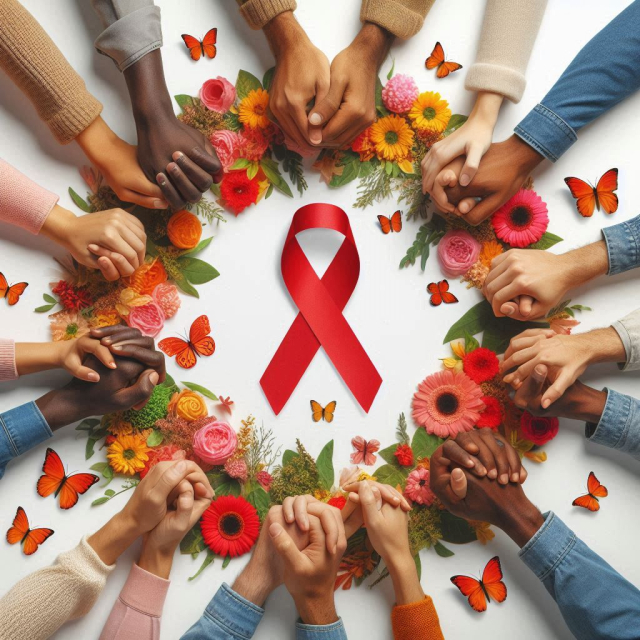Acquired Immune Deficiency Syndrome (AIDS) is a disease that has left an indelible mark on human history since its discovery in the 1980s. Caused by the Human Immunodeficiency Virus (HIV), this disease has affected millions of people around the world and has had a significant impact on public health, politics and society. In this article, we will explore the origin of AIDS, its global impact, advances in treatment and prevention, and the challenges that remain in the fight against this disease.
Origins of AIDS and HIV.
HIV is a retrovirus that affects the body's immune system, weakening the body's ability to fight infections and diseases. HIV-1, the most common and virulent type, is believed to have originated from a similar virus in chimpanzees in Central Africa. Zoonotic transmission of the virus to humans probably occurred through hunting and consumption of meat from infected animals.
The first documented case of what would later be identified as AIDS was in 1981, when the Centers for Disease Control and Prevention (CDC) in the United States reported on a group of young men in Los Angeles who suffered from a rare form of pneumonia (Pneumocystis carinii) and an unusual type of cancer (Kaposi's sarcoma). These unusual cases of opportunistic diseases led researchers to discover a new virus that weakened the immune system.
In 1983, French scientists Luc Montagnier and Françoise Barré-Sinoussi of the Pasteur Institute in Paris identified HIV as the causative agent of AIDS. For this discovery, Montagnier and Barré-Sinoussi received the Nobel Prize in Medicine in 2008.
Global Impact of AIDS.
The AIDS Pandemic.
Since its discovery, AIDS has become a global pandemic. According to UNAIDS, in 2020 there were approximately 37.6 million people living with HIV worldwide. Sub-Saharan Africa is the most affected region, with more than two-thirds of all people living with HIV in the world.
The AIDS pandemic has had a devastating impact on public health and exacerbated social and economic inequalities. In many countries, the high prevalence of HIV has resulted in a significant decrease in life expectancy and has had profound effects on families and communities.
Stigma and Discrimination.
AIDS has also been accompanied by significant stigma and discrimination towards people living with HIV. This stigma has prevented many people from seeking testing and treatment, exacerbating the spread of the virus. Additionally, discrimination has disproportionately affected vulnerable groups, including men who have sex with men, sex workers, injection drug users, and transgender people.
Global Response and Prevention Programs.
The global response to AIDS has been multifaceted, involving governments, non-governmental organizations (NGOs), health institutions and affected communities. In 1996, UNAIDS was established to coordinate the international response to the HIV/AIDS epidemic. Since then, numerous prevention, education and treatment programs have been implemented around the world.
Advances in Treatment and Prevention.
Antiretroviral Therapy (ART).
One of the greatest advances in the fight against AIDS has been the development of antiretroviral therapy (ART). Introduced in the 1990s, ART uses a combination of medications that inhibit HIV replication, allowing the body's immune system to recover and prevent progress to AIDS. ART has transformed HIV from a death sentence to a manageable chronic disease for many people.
Pre-exposure prophylaxis (PrEP) and post-exposure prophylaxis (PEP).
In addition to ART, effective prevention strategies such as pre-exposure prophylaxis (PrEP) and post-exposure prophylaxis (PEP) have been developed. PrEP is a preventive medication that HIV-negative people can take daily to reduce the risk of HIV infection. PEP, on the other hand, is an emergency treatment that can be taken after possible exposure to HIV to prevent infection.
Tests and Diagnosis.
HIV testing has improved significantly, allowing for earlier and more accurate detection of the virus. Rapid HIV testing, which can provide results in minutes, has increased access to testing and made it easier to link people to treatment and care. Early diagnosis is crucial to initiate ART on time and improve health outcomes.
Education and Awareness Campaigns.
Education and awareness campaigns have been essential in HIV prevention. These campaigns have promoted the use of condoms, the reduction of risk behaviors and the importance of getting tested for HIV. HIV/AIDS education in schools and communities has helped reduce stigma and foster a broader understanding of the disease.
Persistent Challenges.
Access to Treatment and Care.
Despite advances in treatment and prevention, access to ART and other health services remains a challenge in many parts of the world. Lack of health infrastructure, medication costs, and discrimination continue to be significant barriers to accessing treatment. It is crucial to continue working to ensure that all people living with HIV can access the care they need.
Research and Development of a Vaccine.
The development of an effective HIV vaccine has been a key objective in HIV/AIDS research. Despite numerous efforts, a vaccine that provides complete protection against the virus has not been developed. However, clinical trials and research continue, and promising progress has been made in the development of innovative vaccines and treatments.
Focus on Prevention and Education.
Prevention remains a crucial component in the fight against HIV/AIDS. It is necessary to continue investing in prevention and education programs, especially in vulnerable and high-risk communities. Promoting safe sex, reducing needle sharing, and continuing HIV education are essential to preventing new infections.
The Future of the Fight against AIDS.
Technological and Therapeutic Innovations.
The future of the fight against AIDS depends largely on technological and therapeutic innovations. Advances in biotechnology, genomics and artificial intelligence are opening new avenues for HIV treatment and prevention. Gene therapy and next-generation vaccines are promising areas of research that could change the HIV/AIDS landscape in the future.
Comprehensive Approach and Human Rights.
It is essential to adopt a comprehensive approach that addresses not only the medical aspects of HIV/AIDS, but also the social and economic determinants of health. This includes promoting human rights, fighting discrimination and empowering affected communities. A human rights-based approach is essential to ensure that everyone, regardless of their situation, can access the necessary care and support.
Global Collaboration.
The fight against AIDS requires continued global collaboration. Governments, NGOs, health institutions, the private sector and communities must work together to coordinate efforts, share resources and knowledge, and address the pandemic comprehensively. Solidarity and international cooperation are essential to achieve sustainable progress in the eradication of AIDS.
AIDS has been one of the most devastating pandemics in modern history, but it has also been a catalyst for scientific advancement and global solidarity. Through research, education, treatment and prevention, significant progress has been made in the fight against HIV/AIDS. However, challenges remain, and a continued, collaborative effort is necessary to eradicate this disease and ensure an HIV/AIDS-free future for generations to come.






